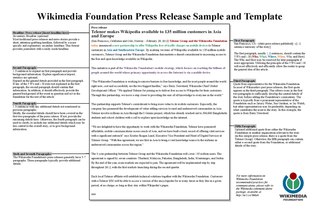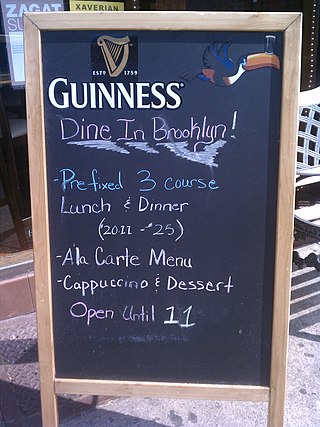Related Research Articles
The ellipsis... is a series of dots that indicates an intentional omission of a word, sentence, or whole section from a text without altering its original meaning. The plural is ellipses. The term originates from the Ancient Greek: ἔλλειψις, élleipsis meaning 'leave out'.
In information handling, the U.S. Federal Standard 1037C defines a hard copy as a permanent reproduction, or copy, in the form of a physical object, of any media suitable for direct use by a person, of displayed or transmitted data. Examples of hard copies include teleprinter pages, continuous printed tapes, computer printouts, and radio photo prints. On the other hand, physical objects such as magnetic tapes, floppy disks, or non-printed punched paper tapes are not defined as hard copies by 1037C.
In English writing, quotation marks or inverted commas, also known informally as quotes, talking marks, speech marks, quote marks, quotemarks or speechmarks, are punctuation marks placed on either side of a word or phrase in order to identify it as a quotation, direct speech or a literal title or name. Quotation marks may be used to indicate that the meaning of the word or phrase they surround should be taken to be different from that typically associated with it, and are often used in this way to express irony. They are also sometimes used to emphasise a word or phrase, although this is usually considered incorrect.
News style, journalistic style, or news-writing style is the prose style used for news reporting in media such as newspapers, radio and television.
A paragraph is a self-contained unit of discourse in writing dealing with a particular point or idea. Though not required by the orthographic conventions of any language with a writing system, paragraphs are a conventional means of organizing extended segments of prose.

The inverted pyramid is a metaphor used by journalists and other writers to illustrate how information should be prioritised and structured in prose. It is a common method for writing news stories and has wide adaptability to other kinds of texts, such as blogs, editorial columns and marketing factsheets. It is a way to communicate the basics about a topic in the initial sentences. The inverted pyramid is taught to mass communication and journalism students, and is systematically used in English-language media.

A press release is an official statement delivered to members of the news media for the purpose of providing information, creating an official statement, or making an announcement directed for public release. Press releases are also considered a primary source, meaning they are original informants for information. A press release is traditionally composed of nine structural elements, including a headline, dateline, introduction, body, and other components. Press releases are typically delivered to news media electronically, ready to use, and often subject to "do not use before" time, known as a news embargo.

Pumpernickel is a typically dense, slightly sweet rye bread traditionally made with sourdough starter and coarsely ground rye. It is sometimes made with a combination of rye flour and whole rye grains.

A typographical error, also called a misprint, is a mistake made in the typing of printed or electronic material. Historically, this referred to mistakes in manual typesetting. Technically, the term includes errors due to mechanical failure or slips of the hand or finger, but excludes errors of ignorance, such as spelling errors, or changing and misuse of words such as "than" and "then". Before the arrival of printing, the copyist's mistake or scribal error was the equivalent for manuscripts. Most typos involve simple duplication, omission, transposition, or substitution of a small number of characters.

An eggcorn is the alteration of a phrase through the mishearing or reinterpretation of one or more of its elements, creating a new phrase having a different meaning from the original but which still makes sense and is plausible when used in the same context. The word "eggcorn" is itself an eggcorn, derived from acorn. Eggcorns often arise as people attempt to make sense of a stock phrase that uses a term unfamiliar to them, as for example replacing "Alzheimer's disease" with "old-timers' disease", or Shakespeare's "to the manner born" with "to the manor born".

Homogeneity and heterogeneity are concepts relating to the uniformity of a substance, process or image. A homogeneous feature is uniform in composition or character ; one that is heterogeneous is distinctly nonuniform in at least one of these qualities.

Webster's Third New International Dictionary of the English Language, Unabridged was published in September 1961. It was edited by Philip Babcock Gove and a team of lexicographers who spent 757 editor-years and $3.5 million. The most recent printing has 2,816 pages, and as of 2005, it contained more than 476,000 vocabulary entries, 500,000 definitions, 140,000 etymologies, 200,000 verbal illustrations, 350,000 example sentences, 3,000 pictorial illustrations and an 18,000-word Addenda section.
Machine-readable dictionary (MRD) is a dictionary stored as machine-readable data instead of being printed on paper. It is an electronic dictionary and lexical database.
The term "journalism genres" refers to various journalism styles, fields or separate genres, in writing accounts of events.

The history of sentence spacing is the evolution of sentence spacing conventions from the introduction of movable type in Europe by Johannes Gutenberg to the present day.

This list comprises widespread modern beliefs about English language usage that are documented by a reliable source to be misconceptions.
The word data is most often used as a singular mass noun in educated everyday usage. However, due to the history and etymology of the word, considerable controversy has existed on whether it should be considered a mass noun used with verbs conjugated in the singular, or should be treated as the plural of the now-rarely-used datum.
Doomscrolling or doomsurfing is the act of spending an excessive amount of time reading large quantities of negative news online. In 2019, a study by the National Academy of Sciences found that doomscrolling can be linked to a decline in mental and physical health.
This glossary of journalism is a list of definitions of terms and concepts used in journalism, its sub-disciplines, and related fields, including news reporting, publishing, broadcast journalism, and various types of journalistic media.
References
- 1 2 Carol (November 28, 2000). "The Mavens' Word of the Day: lede". RandomHouse.com. New York: Random House/Bertelsmann. "Maven's Word of the Day" blog (defunct as of 2012). Archived from the original on 19 February 2012. Retrieved 2012-02-28. This tertiary source reuses information from other sources but does not name them.
- ↑ Peha & Lester (2006). Be a Writer: Your Guide to the Writing Life!: Proven Tips and Powerful Techniques to Help Young Writers Get Started. Leverage Factory. p. 125. ISBN 9780977300006.
- ↑ Spark, David; Harris, Geoffrey (2010). Practical Newspaper Reporting. Sage Publications. pp. 89, 90, 94, 167. ISBN 9781473903340.
- 1 2 3 "Standfirst". Double-Tongued Dictionary . 15 October 2004. Retrieved 27 September 2010.
- ↑ Pope, Geoff (18 November 2010). ""Foreword" Versus "Forward"". Grammar Girl's Quick and Dirty Tips. Macmillan Holdings, LLC. Retrieved 8 December 2019.
- ↑ "Lede". Merriam-Webster Online. Chicago, IL, US: Encyclopædia Britannica, Inc. 2012. Retrieved 2012-02-28.
- 1 2 "lede, n.2". Oxford English Dictionary. Retrieved 1 July 2019.
- ↑ Harpel, Oscar (1870). Harpel's Typograph, or Book of Specimens. Self-published. p. 246.
thin strip of metal separating lines of type.
- ↑ "Bury the lede or bury the lead: which is right?". Merriam-Webster Online.
- ↑ Owens, Howard (September 18, 2011). "lede-vs-lead". HowardOwens.com. New York: Owens Press. Retrieved 2016-06-28.
- ↑ William Metz (1977). Newswriting: from lead to "30". Prentice-Hall. p. 62. ISBN 978-0-13-617514-8.
- ↑ Louis Martin Lyons (1965). Reporting the news: selections from Nieman reports. Belknap Press of Harvard University Press. p. 286.
- ↑ Grant Milnor Hyde (November 2008). Newspaper Editing - A Manual for Editors, Copyreaders and Students of Newspaper Desk Work. Read Books. ISBN 978-1-4437-2632-0.
- ↑ Carl G. Miller (1962). Modern Journalism. Holt, Rinehart and Winston. p. 33. ISBN 9780030027307.
- ↑ Frank Luther Mott (2000). American Journalism: A History of Newspapers in the United States Through 250 Years, 1690–1940. Routledge/Thoemmes Press. ISBN 978-0-415-22893-0.
- ↑ "Lead vs. lede". Grammarist.com. 28 March 2011. Retrieved 8 December 2019.